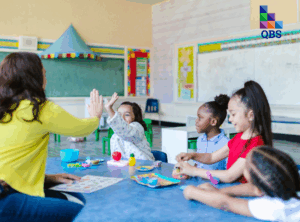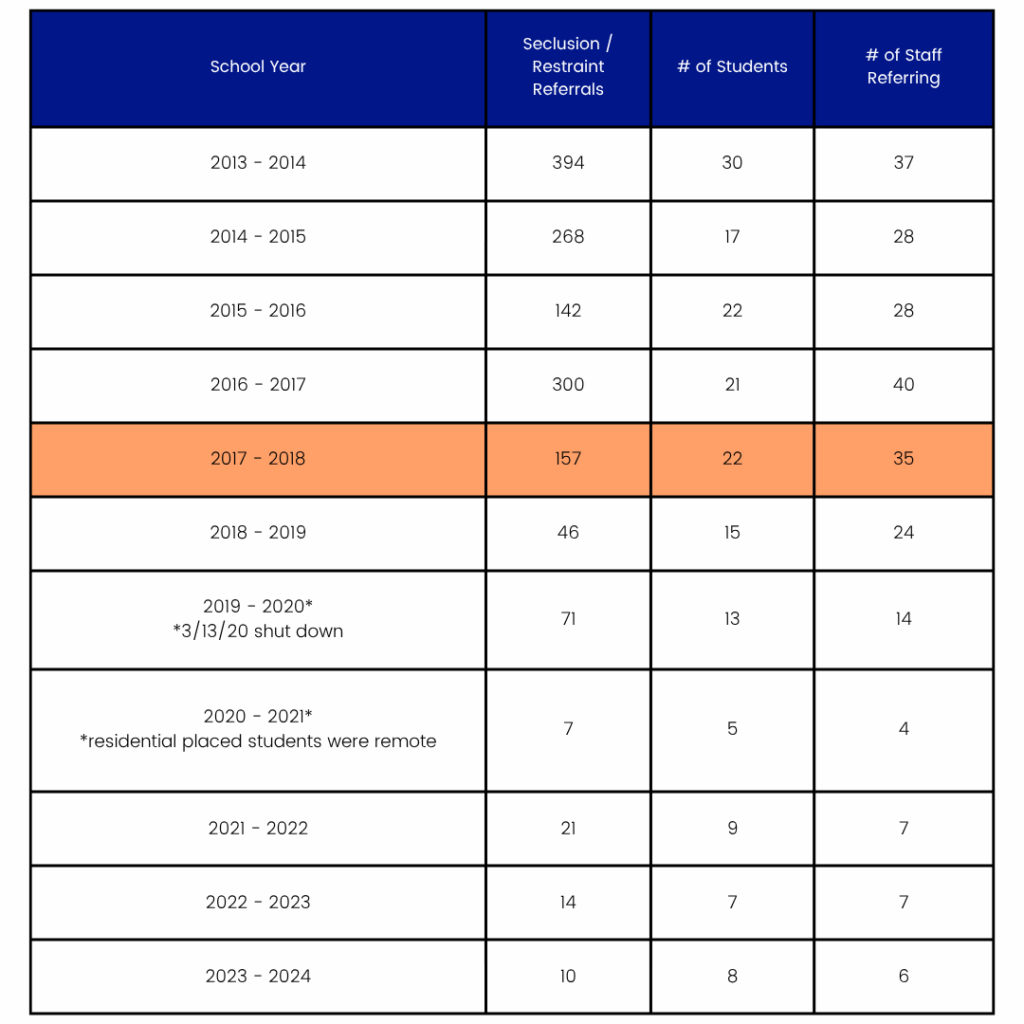Highland Pines School, a center-based school within the Tuscola Intermediate School District (TISD) in Michigan, successfully implemented the Safety-Care behavioral crisis prevention program in 2016. This case study examines how the school transformed its approach from reactive behavioral management to proactive de-escalation, resulting in significant improvements in student behavior and staff safety.

Organization Background
Highland Pines School is a specialized education center serving 123 students aged 5-26 years with various diagnoses including:
- Moderate Cognitive Impairment (MoCI)
- Severe Cognitive Impairment (SCI)
- Severe Multiple Impairments (SXI)
- Autism Spectrum Disorder (ASD)
The school employs approximately 120 staff members and provides comprehensive special education services, with many students exhibiting severe behavioral challenges.
The Challenge
Prior to Safety-Care implementation, Highland Pines utilized a different crisis prevention training but faced several challenges, including a lack of proactive behavioral intervention strategies and a more reactive approach to student behaviors. Between 2013 and 2017, instances of restraint ranged from 142 to almost 400 per school year.
During this time, new State of Michigan restraint & seclusion guidelines were being developed, which were later approved and released by the State Board of Education in March 2017. Any behavioral training curriculum would have to adhere to these updated guidelines, which included requirements that staff must receive training in proactive practices to ensure student dignity, de-escalation techniques, and how to identify behaviors and factors that may trigger emergency situations, beyond just the safe use of restraint and seclusion.
The Solution
Safety-Care was recommended to the school’s Principal and Assistant Principal by a social worker familiar with the training and employed by Highland Pines School (HPS). HPS decided to pilot the training program and initially had 4 employees trained as Safety-Care trainers in March 2016. Staff trained as trainers were selected across different disciplines and based on their ability to promote the new training approach and build buy-in with other staff members. An additional 6 staff members received Safety-Care Trainer training in October 2016.
Implementation Strategy
Classroom staff working with students engaging in the most severe challenging behaviors were trained first. Training of all school staff, from paraprofessionals to nursing staff to bus drivers, was completed by June 2016. Classroom staff working with more severe behaviors were then certified in Safety-Care’s Advanced Module to provide further support to students and staff. After initial certification, staff participated in bi-weekly practice prior to the school day to strengthen and maintain their skills.
It was important to HPS that administrators were trained alongside all other staff. Administrators were very honest regarding the philosophy change that was going to happen with this new implementation and that the biggest challenge would be the approach to de-escalating behaviors proactively rather than managing more severe behaviors. Leadership required care calls and debriefing meetings following behavioral incidents in an effort to mitigate this challenge.
The Results
Safety-Care has led to a reduction in restraint & seclusion referrals in Highland Pines School over the several years, from a high of 394 referrals in the 2013-3014 school year (SY) to only 10 referrals in 2023-2024. The number of students being referred has decreased from 30 per year to 8, with only 6 staff making the referrals as opposed to 37 in the 13-14 SY.
When Safety-Care was first implemented, the number of restraint and seclusion referrals decreased from 300 the previous year to only 157 for the 2017-2018 SY. Since its adoption, the average number of restraint and seclusion referrals per year has dropped from 276 to 17. The students being referred has dropped from an average of 22.5 to 11.3 and the number of staff making these referrals has decreased from an average of 33.25 to 13.9.

**Highlighted school year indicates first year Safety-Care was fully implemented
Cultural Transformation
As with any significant procedural change, there was initial pushback with the adoption of Safety-Care, however, because of the 100% buy-in from leadership, there was a mind shift that occurred over the first year and a half of piloting the training. Admin staff and a Safety-Care trainer are always present with staff when codes are called for behavioral incidents, and emphasis is put on using de-escalation (i.e. Safety-Care’s Wait strategy) rather than using a hands-on approach.
The leadership team at HPS report that Safety-Care has changed the culture of the building for the better. Trainers are all in on Safety-Care, and if they notice staff needing practice, they arrange to re-train them for additional support. Trainers still provide regular monthly practice sessions for all staff. Courtney Dunham, Special Education teacher & Safety-Care trainer, says, “We predetermine a few topics for upcoming months, then re-evaluate. What do we see staff need more help with, if we see errors occur, or just reminders of variations that we can use as talking points. Topics are relevant to what’s happening in school rather than just randomly selected.”
Staff report loving the training and intervene in a proactive and effective manner when they see signs of frustration in a student, such as making small changes to a schedule or routine to help students be more successful. Staff have learned skills to help de-escalate situations and reduce major incidents, creating a more successful learning environment for students. “Being a teacher and a Safety-Care trainer,” says Dunham, “those first few chapters of the core curriculum, using Help, Prompt, and Wait (de-escalation strategies), becomes how we teach; it’s second nature. We’re more proactive instead of reactive. Before Safety-Care, we didn’t have those tools.”
Student behavior has also been impacted. “When students go from one classroom to another, expectations are going to be relatively the same,” says Dunham. Principal Tracey Henry adds, “The progression we’re seeing is that students respond appropriately when codes are called. It’s so smooth.” Students have learned how to use their voice to convey their frustrations and there has been an increase in students earning monthly PBIS awards due to the decrease in challenging behaviors.
Overall, the cultural shift has been significant. Principal Tracey Henry reported that principals and leadership from nearby schools are not seeing the same dramatic results that Highland Pines has experienced. “What I’ve noticed”, she says, “is they are smaller teams and not everyone is trained. There’s no ownership to it. At Highland Pines, we’re all invested. Our teachers take ownership of the behaviors. By all of us being trained, we’re comfortable with it. When we debrief, it’s never a blame game. It’s what could we have done differently? What could we be more proactive with? Safety-Care works because we’re all invested. We’re invested in the students, we’re invested in the staff.”
Broader Impact
The success at Highland Pines led to the adoption of Safety-Care by all local schools in the district within 2 years of HPS adopting Safety-Care. Now every school in the district has its own trainer and Safety-Care response team. TISD has shared their data with other local ISDs and will be opening its schools to tours to show the effects of the training and how it is utilized.
Conclusion
Highland Pines School’s implementation of Safety-Care demonstrates how a proactive behavioral intervention program focused on prevention and de-escalation of challenging behavior can transform school culture and improve outcomes for both students and staff. The success of this implementation has made Highland Pines a model for other schools seeking to enhance their behavioral support systems.
About Highland Pines School
Highland Pines School is part of the Tuscola Intermediate School District located in Caro, MI. Highland Pines provides programs for the Early Childhood Education, Moderately and Severely Cognitive Impaired, and Severely Multiply Impaired. Their programs include adaptive physical education, aquatics, music therapy, activities of daily living and community living.
 By using our site, you consent to our use of cookies to enhance functionality and analyze site performance.
By using our site, you consent to our use of cookies to enhance functionality and analyze site performance.